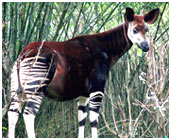Okapi is a relatively unknown animal, founds mainly in Congo. In this article, we have provided some interesting facts and amazing information on okapis.
Facts About Okapi
Okapi is a mammal, which is found inhabiting the regions of north, central and eastern Congo. One of the most distinctive features of the animal is its appearance. It has a dark back, with striking horizontal white stripes on the front and back legs. This is the why an okapi is, many times, mistaken for a zebra, especially from a distance. Okapis belong to the same family as giraffe and in fact, have quite a similar body shape too. The tongue of an okapi is so long that it can wash its eyelids and even clean its ears. Indeed, okapi is one of the few mammals in this world that can lick their ears. When okapis were first discovered, there were about 40,000 of them in existence. Now, the estimated population is less than 10,000. To know more about the animal, check out the interesting facts and amazing information given below.

Fast Facts
Binomial Name: Okapia johnstoni
Common Name: Okapi and Forest Giraffe
Kingdom: Animalia
Phylum: Chordata
Class: Mammalia
Order: Artiodactyla
Family: Giraffidae
Subfamily: Okapiinae
Genus: Okapia
Species: O. johnstoni
Length: 1.9 to 2.5 m (up to 8.1 ft)
Height: 1.5 to 2.0 m (up to 6.5 ft)
Tail: 30 to 42 cm (12 to 17 inches)
Weight: 200 to 250 kg (465 to 550 lb)
Diet: Herbivorous
Natural Habitat: Dense and damp forests
Age: 30 to 33 years
Gestation Period: 427 to 491 days
Number of Offspring: 1
Interesting & Amazing Information on Okapis
-
Okapis are mainly solitary creatures, who come together only to mate and breed. The only groups seen are those of mother and offspring.
-
Okapis scavenge through the forest, along fixed and well-trodden paths.
-
Okapis mark their territory either by leaving behind a tar-like substance from their foot or by urine marking.
-
Though okapis prefer altitudes of 500 to 1,000 m, they may venture above 1,000 m in the eastern mountain rainforests.
-
The diet of an okapi comprises of tree leaves and buds, grass, ferns, fruit, and fungi.
-
The existence of the okapi was confirmed, for the first time, in Congo, in the year 1901.
-
Okapis have a very long tongue, mainly used for the purpose of pulling leaves off trees.
-
Okapis are ruminants i.e. they swallow their food initially and later regurgitate it, for chewing and swallowing it the last time.
-
A male okapi has short skin-covered horns.
-
A female okapi vocalizes only when she is ready to breed.
-
The calf of an okapi has a short fringe of hair, along its spine, at the time of birth and it disappears by the time it’s one year old.
-
The calf of an okapi defecates for the first time between 4 to 8 weeks of age.
-
Okapis have only one natural enemy in the wild - leopard.
-
Sir Harry Johnston was a well-known British explorer and naturalist and he is credited for his expedition to the Ituri Forest in the Democratic Republic of the Congo for acquiring the first specimen of Okapi. As a tribute to him, the Okapi was given the scientific name Okapia Johnstoni.
-
These herbivores not only feed during the daytime, but are also found feeding at nighttime as well.
-
These animals have no gall bladders.
-
Okapis can live up to 33 years.
-
These have big ears, long skulls and huge black eyes.
-
The female okapis do not have horns like the males, but they have bumps on their heads.
-
Okapis are listed in the IUCN Red List of Threatened Species. Loss of habitat due to deforestation and human settlement has led to the reduction of these species.
-
Okapis are prone to bacterial infections, parasitism, fungal diseases and viral diseases.
-
An okapi’s tongue is 18 inches long.
-
Okapis, although usually silent, make certain vocal sounds such as ‘chuff’, ‘bleat’ and ‘moo’.


See also
More in 'Society'
More from iloveindia.com
- Home Remedies | Ayurveda | Vastu | Yoga | Feng Shui | Tattoos | Fitness | Garden | Nutrition | Parenting | Bikes | Cars | Baby Care | Indian Weddings | Festivals | Party ideas | Horoscope 2015 | Pets | Finance | Figures of Speech | Hotels in India : Delhi | Hyderabad | Chennai | Mumbai | Kolkata | Bangalore | Ahmedabad | Jaipur
- Contact Us Careers Disclaimer Privacy Policy Advertise With Us Lifestyle Sitemap Copyright iloveindia.com. All Rights Reserved.




